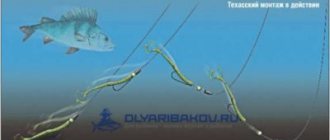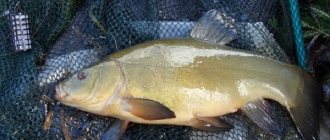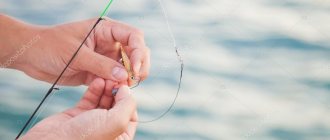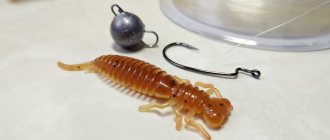The development of fishing techniques with spinning rods leads to the emergence of new modernized equipment. The American invention of the jig rig is effective even with low predator activity. Long casts and high permeability of the gear in the coastal thickets provoke the most sluggish inhabitants to bite, pleasing the natural play of the bait to the fastidious inhabitants.
Jig rig equipment
Description
A new method of supplying silicone bait to a predator has gained popularity due to its ease of installation and catchability. A misconception is the idea that the name jig rig means exclusively a special load in the form of a stick or drop. The novelty of the design is that both the leash and the hook with bait are hinged to the load at one point.
When moving both in the air and in a body of water, the load goes in front, followed by a cord and silicone.
The design was originally invented for fishing for large largemouth bass, or bass, in grassy areas where the predator likes to hide behind vegetation. When the weight falls, it drags the bait attached to an offset hook or cord through the branches. Bites follow during the movement of the rig.
Where is it used and what kind of fish are caught?
Jig rig is designed for fishing in various hard-to-reach places of reservoirs - areas with an overgrown, snaggy bottom, rocky surface, among the crowns of flooded trees, where the risk of snags is very high. But the use of jig rigs by our fishermen on a sandy or muddy bottom proves that the relevance of the installation in other conditions is not lost.
This equipment is perfect for fishing from the shoreline in bodies of water with standing water or weak currents.
Perch on a jig
The appropriate season for using a laconic rig is the cold autumn time, when the fish hides among snags, in recesses, and fallen leaves accumulate at the bottom. A jig-rig installation does not collect leaves, but only passes over them with an elongated sinker.
The name of the installation suggests that the main purpose of the gear is to hunt bottom inhabitants. In our area you can’t find trout perch or bass, but fishing for the usual pike perch, cunning asp, rotan, pike, and catfish is quite possible. Occasionally, trophy burbots and even chubs are caught.
Pike on a jig-rig
Practice shows that catching a passive predator brings success; the game of the bait captivates with its natural mobility.
Lures for jig rig
The peculiarity of the American equipment is that when the load falls, the bait remains a little higher, there is no rapid sticking to the bottom, which means that the luring of fish continues. The equipment collects less small debris, since one weight sinks. Silicone remains in the predator's field of vision; various movements at different angles arouse interest and force an attack. An additional game, longer than that of conventional equipment, enhances the angler’s advantage in situations where the fish is sluggish and refuses to bite.
Types of bait
You can achieve a variety of animations through experimentation. They mainly make silicone equipment; rubber, in combination with a jig rig, acquires new qualities that excite the most passive predator.
It is recommended to select silicone taking into account certain fishing conditions and the characteristics of the reservoir. Sometimes accurate imitations of insect larvae and various crustaceans are required. In general, suitable for hunting:
- twisters, vibrotails - movable silicones that create vibrations in the wiring that lure a predator;
- worms, leeches - passive baits, the animation of which is produced by the tip of the rod.
Some fishermen use foam fish, but such equipment is more appropriate for sandy, muddy, shell bottoms, not littered, without branches, or grassy thickets.
Worm
The size is selected in accordance with the intended hunting object. For catching small pike perch, large perch, and medium-sized pike, vibrotails and twisters up to 50 mm in length are suitable. Larger specimens will be attracted by a bait 60-75 mm long. Larger specimens will be interested in large silicone ones 80-100 mm.
Crab
It is worth considering the ratio of the dimensions of the silicone and the weight - the silicone should be smaller in diameter. This factor has a good effect on the range of the equipment, one of the most important advantages of installation compared to traditional jig equipment. The disproportion leads to the effect of the bait's windage, constant tumbling, and unnatural play when retrieving.
LUCKY
Vibrotail
Hinged jig installation
Date: February 24, 2015 | 093
Beginning spinning anglers are faced with the question of how to mount their jig baits made of soft plastic or silicone. One of the main installations in microjig fishing is the hinge. The swivel hook and sinker connection is an excellent and most common mounting method. What kinds of hinged installations there are, what elements are used in them, what features they have - these are important questions and we’ll talk about this in detail.
Hinged mounting , today, is the connection of a collapsible eared sinker (the so-called “Cheburashka”) and a hook. Everything is very simple. And, most importantly, it is effective.
The sinker is collapsible. The wire bracket is removed and the hook is placed on it and the weight is reassembled. The hook can be used:
— Single with a large ring;
— Offset;
— Double hook;
- Tee.
Some kind of tackle consisting of several hooks can also be attached. This is especially in demand when installing large silicone baits.
In microjigging, the most popular rigs are those with single hooks with an enlarged ring, as well as those with offset hooks.
This installation gives the bait proper freedom relative to the sinker. The freedom of action of the bait makes its movements more natural and attractive to fish. This is especially true for passive silicone baits, for slugs, worms, crayfish, etc.
Let's compare it with what happened before, before the advent of collapsible eared sinkers.
Cheburashkas were rigidly cast. The hooks had to be attached either through winding rings, or through some kind of wire inserts, or by unbending the hook ring. Of course, collapsible weights are much more advanced and interesting. Their appearances were revolutionary and a very positive innovation.
A silicone bait is attached to the articulated hook. You can simply attach it to the tackle by tying it directly with a knot. You can knit tightly or loosely so that the weight dangles freely in the knot in the shape of a loop.
This method of fastening has one slippery point. The quality of the collapsible weight itself is important here. The wire bracket must be firmly held in the slot of the weight, otherwise, with some sharp jerk, when biting, the bracket may jump out and the bait will be lost in the water. I had this until I bought a series of better earflaps.
To protect yourself from this unpleasant phenomenon, you can fasten the installation using an American fastener. The clasp prevents the weight from moving out.
In addition, the presence of a fastener makes it possible to quickly change baits and change the weight of the weight.
If pike bites often occur, if the sections of the fishing line are worn out, then the mount is attached to a metal leash.
Let's look at the advantages and disadvantages of swivel mounting in comparison with another popular method of equipping silicone - with a jig head.
Advantages of hinged mounting:
— Increased degree of freedom of the bait and more natural play;
— The ability to better present the bait with positive buoyancy (on a hinge, it floats nicely above the bottom, better attracting fish);
— Wide possibility of varying weights of weights with hooks of different types and sizes;
— Longer casting range due to smaller windage (the bait flies after the weight).
Disadvantages of hinged mounting:
— Slightly more snagging installation (can be treated by using an offset hook in places with a large number of snags);
— Not very good compatibility with vibrotails;
— The quality of the hook is worse than that of a jig head;
— The cost of the hook-weight set is higher.
If we analyze the percentage ratio of the use of hinged mounting and jig heads in microjig, then the ratio will be 9 to 1, in favor of the hinge. This is due to better game, freedom of bait, improved range where it is critical. Also, this is due, trivially, to the fact that the vast majority of passive silicone baits that work best with a hinge. There are many types of them, many models. And the use of jig heads is limited to vibrating tails, partly twisters and a very small percentage of passive baits. So, the effectiveness and importance of hinged mounting in modern microjigging can hardly be overestimated.
Share with your friends:
Categories: Installations · Tags: Sinkers, Hooks, Microjig, Installation, Tackle
Advantages and disadvantages
Using the positive aspects gives the maximum result of using a jig in comparison with a hinged mounting or a conventional jig head.
The undeniable advantages of the equipment include:
- long range is the most important advantage for coastal fishing, which is achieved with the help of the elongated shape of the sinker, minimal drag, and small size;
- high passability through snags, low susceptibility to snags;
- an interesting game, attractive for a passive predator in the lower level of a reservoir, movement in place;
- the ability to fish a promising area literally centimeter by centimeter;
- ease of installation, the ability to quickly change loads and select attachments;
- versatility of hunting from small perch to trophy catfish.
The disadvantages include:
- relatively low amplitude of oscillations of the twister and vibrating tail during wiring;
- the high price of winding rings for tungsten weights in sport fishing.
It is unlikely that the disadvantages include the need to purchase high-quality accessories - swivels, fasteners. Thus, this installation has significantly more advantages. It is no coincidence that the jig rig attracts both fishing enthusiasts and professionals.
Advantages and disadvantages of a jig-rig
There is nothing magical or extremely catchy about a jig-rig, as many say. Each installation has both advantages and disadvantages, and only a correct understanding of them and the disclosure of positive qualities to the maximum gives a good result.
ADVANTAGES
- an interesting game of bait and a great flight of fancy for animation with dragging along the bottom and at the lowest horizon from it;
- range is a very big plus for coastal fishing;
- maneuverability of the equipment, the jig-rig is less susceptible to snags.
- quick change of weight and bait - the clasp allows you to quickly select the weight and suitable bait.
FLAWS
- fasteners, swivels - all these are weak elements in the equipment when catching trophy fish - you should use good, high-quality fittings;
- vibrating tails play worse and are served less accurately than on a jig head;
- a non-fixed and chaotic position of the hook increases idle bites and makes it worse to spot fish.
This video can be called an encyclopedia of jig-rig. It describes in great detail all the nuances, pros and cons of this equipment, and discusses wiring options.
Mounting options
To carry out a classic assembly, the following basic elements are required:
- driven weight with a loop;
- offset hook;
- a pair of winding rings;
- bait.
Installation algorithm:
- select a weight (shape, weight correlated with fishing conditions) with a loop for tying the fishing line;
- attach a pair of connected rings to the loop;
- insert an offset hook into the outer ring.
In general, the installation of jig-rig equipment is ready. You need to tie it by the middle ring to the main fishing line and put on a silicone bait.
Installation elements
In addition to the main option, slightly modified installation schemes are used:
- Instead of the main winding ring, a leash with a carabiner is knitted, to which an offset hook with a silicone bait and a sinker on a swivel are attached. This improvement allows you to quickly replace baits and sinkers.
- A cord, a silicone bait on a hook, and a weight on a swivel are attached to the main winding ring.
It is worth paying attention to the following installation feature: first of all, put a hook on the fastener, followed by a sinker. When a predator hits its head while fishing, the clasp may open. The sinker in front will not allow the victim to fall off; the carbine will interfere. Otherwise, the hook will slip off the clasp, and the predator will feel free.
Ready-made rigs can be bought at a fishing store; many people assemble them themselves.
Ready from the commercial network
For fishing in the fall, when the fish move away from the shore, a particularly long cast with lightweight installation is required. They assemble a micro jig-rig according to the same principles, but choose small hooks, carabiners, baits up to 5 cm long, weights of 1-6 g. Buying miniature elements is problematic, so a sinker-pellet is taken from a set of equipment with a float, clamped on a swivel ring.
Jig for perch
Experienced fishermen improve installation with a short leash made of braided cord from the winding ring to the tee. The positive side is that after a perch or pike perch bites, the bait remains intact. But this equipment is not suitable for reservoirs full of pike, for which the leash is the weak link. How to tie a hook.
Jig-rig fishing technique
Installation can be used in almost any conditions thanks to the selection of equipment elements. Offset hooks are recommended for use in remote, overgrown areas of water bodies. Offset hooks are used for catching pike. The jig rig was originally conceived for fishing among grassy thickets in the water. Where there is a clean bottom, simple models with a long fore-end or a double are suitable.
Selection of cargo and bait
In amateur fishing, lead weights of various shapes are usually used: cone-shaped, teardrop-shaped, sticks. At competitions, tungsten analogues are used, which are significantly smaller in volume with equal mass.
If you need to cast as far as possible, you should prefer a weight in the form of a stick; if necessary, it is better to capture the behavior of the bait; it is recommended to choose a weight that is a drop or in the shape of an olive.
Types of weights
Since range is important to many fishermen, it can be achieved provided that the size of the bait does not exceed the cross-section of the load. For bait it is better to use a vibrating tail or a worm. Do not forget about the proportionality of the sinker, bait, and hook to the intended prey.
Wiring methods
It is believed that any of the jig wiring is suitable for a jig rig, but taking into account the specifics of the fishing area and potential catch. Four main types are considered:
- “stepped” - perform several rewinds after casting the equipment with 2-3 turns of the reel with pauses lasting 2-4 seconds. Wiring works effectively with an active predator, which is attracted by the non-standard game of the jig;
- uniform - carried out by gradual continuous winding of the cord;
- dragging along the bottom - used to attract a sluggish predator that is not interested in other equipment or wiring techniques. Movement along the bottom soil creates a trail of turbidity, thereby imitating small fish that dig around in search of food;
- playing in the same place - perform animation without winding the cord, with light tosses with the tip of the fishing rod. Under the influence of the current, the equipment moves slightly. Wiring is effective when fishing for pike and pike perch in overgrown places, among snags. The equipment allows you to fish holes, “windows” among vegetation. Using edible silicone increases the chances of success.
Photo of a trophy pike
Experienced fishermen invent their own methods of fishing based on basic techniques. Fishing with a jig rig becomes universal and maintains catchability.
DIY jig rig installation video
Wiring with jig rig equipment
Continuing the topic of jig-rig installation, we cannot help but mention the wiring methods, because the Jig Rig is quite versatile and allows you to work with various types of wiring, below I will list the main ones:
- A standard jig step is most relevant in places with high angler pressure. In this case, the jig-rig rig will allow you to diversify the game and a predator that is already familiar with standard spinning rigs will certainly show interest.
- Dragging the bait along the bottom is used against passive fish. Slow retrieving is done by pulling the rod or winding the reel, periodically, it is worth making pauses of 2-6 seconds or jumping with the load. During pauses, you can give the bait a little play by gently playing with the tip of the spinning rod. Various worms, octopuses, crayfish and animal baits are used as bait.
- Wiring in a standing position is used when it is necessary to probe an interesting point on a body of water. This could be a submerged stump or snag, clearly defined unevenness of the bottom topography (hole, tubercle), or a small window among water thickets. This type of wiring is effective, especially if the fish behaves very passively. For playing in one place, baits with creatures (tentacles, tails and other growths) are excellent.
- To drift against the current. The essence of the method is that we let the current carry our bait down, and then we reel it in, holding the equipment against the current, see Fig. 1.
This method is convenient for fishing rifts with medium and shallow depths. This method is effective in the early morning during the warm season, when perch and pike perch stand at these points and actively feed.











